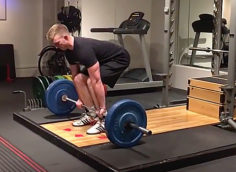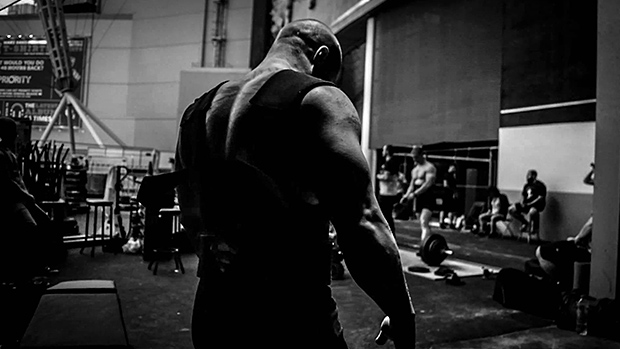I confess: I do not have a favorable
impression of young men in the 16-to-24-year-old age group.
I get emails from them on a daily basis, and
in my experience they're looking to be spoon-fed free
information. The free articles on my website (not to mention the
thousands on T-Nation) aren't enough. Using them would
require some research, God forbid, and that would eat into their
PlayStation time.
Instead they ask me questions like this:
"What's the best program in the
world for building big guns?"
"What supplements should I be
taking?" (Hint: If you don't have any money, the
answer is none. Focus on food.)
"How can I get a six-pack in time for
spring break?" (This is typically asked a week before spring
break.)
In the past I've made the mistake of
answering emails like these, only to be bombarded with 15 follow-up
emails asking increasingly moronic questions.
So when TC asked me to write a series of
articles specifically addressing the needs and interests of this
age group, my first instinct was to ask why. Why tailor great
information to a generation so willfully uninformed?
TC's answer: so they'll know
what to do when they're ready to take training
seriously.
I have to admit that's a damned good
answer, and the fact you're reading this is proof that I
decided to take the assignment.
Let me start with a general comment:
Most of us under 40 are addicted to
entertainment. The younger you are, the greater your need to be
entertained at all times. That's why I call the kids
who're 16 to 24 "Generation Entertainment" (or
Gen Ent if you're into that whole brevity thing).
When we aren't watching four hours of
TV every night, we're surfing the Web or sending idiotic
text messages to our friends laced with infuriating acronyms. As a
result, we're getting fatter and weaker. Even worse,
we've lost any semblance of mental toughness. We have no
concept of sacrifice.
Since we've screened out anything that
isn't entertaining, few of us can slog through weeks and
months of boring training. But the problem is even worse for Gen
Ent. Unless training is fun and consistently stimulating, the
dumbbells will gather dust long before any of it appears on the
Game Cube.
Now, given everything I've just said,
you'd think that I'd start this series with something
sexy, like abs or biceps. Nope. I'm going to show you a
better way to do the most boring type of exercise known to man.
Cardio: the remix
When you think of cardio, what comes to mind?
Deconditioned schlubs trudging joylessly on treadmills?
Overcaffeinated Spinning addicts cranking like madwomen on a bike
going nowhere?
<!-- 
With
enough Ritalin …
-->
Cardio, the way most people do it, is a severe
form of mental-toughness training. But I don't mean that in
a good way. It takes a lot of mental toughness to do that kind of
cardio training five times a week for months on end. But it
doesn't do much for your body. Unless you're born
with good genetics for endurance training, it's probably not
going to make you much leaner than you are now.
Fortunately, there are plenty of alternatives
that are both fun and effective. They produce fast results with no
boredom required. And best of all, they're cheaper than
basic cable.
Gen Ent Training, Option 1: It's hammer
time!
If you're a member of Gen Ent, chances
are you have more Testosterone than you know what to do with. This
sledgehammer workout channels all that hormonal aggression into a
productive activity. On top of the obvious fat-fighting and
endurance-building benefits, it's a great conditioning
method for football, wrestling, and martial arts.

The
ultimate paradigm-smashing workout tool
The first thing you'll need is a
long-handled sledgehammer. Start with an eight-pound sledge, with
the idea that you'll work up to a 16-pounder. You
don't need anything fancier than the ones at Home Depot or
Lowe's.
Don't fool yourself about the weight;
we aren't talking about curls or lateral raises here.
Swinging a sledgehammer as hard as you can for hundreds of reps is
a total-body workout. Your forearms, biceps, shoulders, and back
are going to get a workout like they've never had before.
With experience, you'll learn to get your quads and
hamstrings into the act as well.
The second thing you'll need is an old
tire; you can pick one up at any junkyard or tire shop.
Your goal is simple: Hit the tire with the
hammer.
Start with 10 one-minute rounds. Set a timer
for 60 seconds, and hit the tire as hard as possible, and as many
times as possible, for the entire minute.
Take one or two minutes to catch your breath,
then start the next round.
Do three workouts a week with at least one day
in between.
Once you can do all 10 rounds with a 1:1
work-rest ratio – one minute of striking, one minute of rest
– shave 10 seconds off each rest period. Now you're
striking for one minute but resting just 50 seconds in between
rounds.
When you can do 10 rounds of that, shave
another 10 seconds off your rest periods. Keep shortening the rest
periods until you can do all 10 rounds with no rest in between
– in other words, a 10-minute set of sledgehammer
striking.
By that point you'll be a superbly
conditioned athlete, and chances are you'll be shredded as
well.
Now you have two options:
1. Get a 16-pound hammer, and repeat the
entire process, ending with a single 10-minute set.
2. Keep the eight-pounder, but start over with
10 rounds of two minutes each, with one minute of rest in between
rounds. Build up to a single 20-minute set.
To make it more fun, invite some friends over,
and challenge each other. See who can get to the 10-minute and
20-minute sets first.
Sledgehammer workouts are enhanced by intense
music. I enjoy Slayer, Machine Head, and my friend Harley
Flanagan's bands: The Cro-mags (his old band) and
Harley's War (the new one).
Gen Ent Training, Option 2: Hit the sand!
I first heard about sandbag training in the
Brooks Kubik classic Dinosaur
Training.
It's a really fun way to get an
incredibly intense resistance-training workout. My friend Josh
Henkin sells the highest-quality sandbags.
(Josh also has an awesome sandbag-training DVD,
which I've endorsed and highly recommend.)
But even if you're a total cheap-ass
who doesn't want to invest in a high-quality sandbag, you
can still do the workout. Go to your local army-surplus store and
buy two high-quality duffle bags. Then drive to the nearest
hardware store and get three 50-pound bags of sand or wood chips.
(There's no advantage or disadvantage to either choice,
although if you buy the wood chips and leave them around for a
while you could end up with a termite problem – not cool,
especially if you're still living at your parents'
house.)
If you live near a beach, you might be tempted
to take your bags to the beach and fill them up for free, although
I don't recommend it, since it makes the next step kind of
difficult.

When
the levee breaks, you'll be a lot more useful than these
guys.
Now put one 50-pound bag of sand or chips into
one duffel bag, and put the other two bags into the other duffel.
For those who aren't good at basic math, you now have one
bag that weighs 50 pounds and another that weighs 100.
Those weights only sound light if
you've never done sandbag training. If you have, you know
that working with a 100-pound sandbag is much harder than working
with 100 pounds on a barbell. Everything you do with a sandbag is
going to work hundreds of stabilizer muscles, from your fingers to
your core to the muscles and connective tissues your feet. The
strength and power you build with sandbag training will transfer to
football and combat sports.
But even if you don't care about core
stability or combat conditioning, working with a sandbag is a great
way to get your heart pumping, boost your muscle strength and
endurance, lose fat, and have a blast doing it.
Here's a sample sandbag workout.
Exercise descriptions and photos follow the workout (photos are
courtesy of the aforementioned Josh Henkin).
1A)
Sandbag clean and push press, 1x10
Rest 60 seconds
1B) Sandbag bent-over row, 1x10
Rest 60 seconds
1C) Shoulder get-up, 1x5 (each side)
Rest 60 seconds
1D)
Sandbag shoulder squat, 1x10 (each side)
Rest 60 seconds
1E)
Sandbag carry, 1x50 yards
Rest 90 seconds, then repeat the five-exercise
sequence. Do a total of five circuits. Choose the more appropriate
sandbag for each exercise – probably the 50-pound bag for the
get-up and carry, and 100 pounds for the clean and press, row, and
squat.
As with the sledgehammer workout, your goal is
to cut the rest period between exercises by 10-second increments.
You want to get to the point at which you can do the entire circuit
with no breaks between exercises.
Start with three sandbag workouts per week,
with at least one day in between.
If you want to try both, you could do the
sledgehammer workout on Monday and Thursday, and the sandbag
workout on Tuesday and Friday. I don't recommend doing this
type of training more than two days in a row, or more than four
times in any seven-day period.
Sandbag clean and push press
Stand over the bag as you would for a
deadlift, grabbing it at the sides with your palms turned toward
each other. You want your arms straight, hips creased, knees bent,
and chest up.
Push down through your heels and stand as you
pull the bag to your chest. Your elbows will end up underneath the
bag. Do a rapid quarter squat, then quickly reverse the motion and
use your entire body to help push the bag overhead.
You should move so fast on the push press that
the bag feels weightless to your upper-body muscles until the end
of the movement, when you're holding it overhead with your
arms straight.



Sandbag bent-over row
Grab the bag at the sides and set up as you
would for a barbell bent-over row: arms straight, knees bent, hips
back, spine neutral, and your torso nearly parallel to the
floor.
Pull the bag straight up to your abdomen while
keeping your knees, hips, and torso in the original position.
You can make it more difficult by grabbing the
middle of the bag, rather than the ends.


Sandbag get-up
Lie on your back and place the sandbag on your
right shoulder. Bend your right knee and set your right foot flat
on the ground. Extend your left arm out to your left side.
Roll to your left, using your left arm and
right foot to help you sit up.
Once you're sitting, elevate your hips
and slide your left leg underneath you so you're in a lunge
position with your torso upright.
Now stand, as in the finishing position of a
lunge.
Reverse the sequence to lower yourself. (Do
this slowly and under full control.) Finish your reps with the bag
on your right shoulder, then without resting put it on your left
shoulder and repeat the set.





Sandbag shoulder squat
Lift the bag over your head and onto your
traps and shoulders, roughly mimicking the position of a barbell
during a back squat. You want the weight in the bag to be evenly
distributed, more or less. (The beauty of the exercise is that
you'll never get it exactly balanced; the slight imbalance
will make it more challenging and give your stabilizing muscles a
better workout.)
Set your feet however you normally would for a
back squat – probably just wider than your shoulders, with
your toes pointed straight ahead or angled out slightly. Push your
hips back and squat down until your upper thighs are parallel to
the ground.
Avoid compensating for any weight imbalance,
or for the sand shifting in the bag – don't lean
forward or twist to rebalance the weight, in other words. Your goal
is to achieve the same form you would with a barbell on your
shoulders, despite the fact the weight is awkward and the balance
is unpredictable.


Sandbag carry
You can carry the sandbag for the required 50
yards in any of the following ways.
Introductory: Zercher (holding it in crook of
your arms in front of you)
Intermediate: shoulders (as in a back
squat)
Advanced: overhead
Keep your body upright and balanced –
don't lean forward or to either side to compensate for the
weight of the bag.
In the next installment of this series,
I'll show some strength-and-size workouts designed for Gen
Ent lifters who find traditional weight training more boring than
Sunday school.





